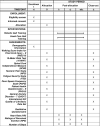Foundational ingredients of robotic gait training for people with incomplete spinal cord injury during inpatient rehabilitation (FIRST): A randomized controlled trial protocol
- PMID: 35536844
- PMCID: PMC9089894
- DOI: 10.1371/journal.pone.0267013
Foundational ingredients of robotic gait training for people with incomplete spinal cord injury during inpatient rehabilitation (FIRST): A randomized controlled trial protocol
Abstract
Introduction: As technological advances allow the use of robotic exoskeleton devices with gait training, there is a critical need to establish a robotic gait training (RGT) program to meet the needs of people with spinal cord injury (SCI) during inpatient rehabilitation. The purposes of this study are to prospectively examine the efficacy of a stakeholder informed RGT program compared to usual care gait training (UC) during inpatient rehabilitation in people with incomplete SCI and compare the intensity of RGT and UC gait training during inpatient rehabilitation.
Study design: 128 patients with incomplete SCI admitted to our inpatient rehabilitation facility will be screened for eligibility and randomized to either the RGT or UC group. RGT sessions will use the Ekso robotic exoskeleton [class II medical device (United States FDA)]. UC sessions will use traditional gait training approaches such as manually assisted overground gait training with walkers and orthotics and body weight-supported treadmill training (BWSTT). Our primary outcome is gait function as characterized by the Walking Index for Spinal Cord Injury-II (WISCI-II). Secondary outcomes are gait speed, Spinal Cord Independence Measure (SCIM), Numeric Pain Rating Scale (NPRS), Fatigue Severity Scale (FSS), Penn Spasm Frequency Scale (PSFS), Patient Health Questionnaire-9 (PHQ-9), General Anxiety Disorder- 7 (GAD-7), International Spinal Cord Injury Quality of Life Basic Data Set, and a Qualitative Questionnaire. Assessments of primary and secondary outcomes will occur at admission and discharge from inpatient rehabilitation. General or generalized linear models will be used to analyze differences between groups for all measures.
Clinical impact: Successful completion of this study will provide a usable, replicable, stakeholder informed RGT intervention for use with individuals with incomplete SCI during inpatient rehabilitation.
Conflict of interest statement
The authors have declared that no competing interests exist.
Figures
Similar articles
-
Dosing overground robotic gait training after spinal cord injury: a randomized clinical trial protocol.Trials. 2024 Oct 18;25(1):690. doi: 10.1186/s13063-024-08503-0. Trials. 2024. PMID: 39425122 Free PMC article.
-
Overground Robotic Exoskeleton Gait Training in People With Incomplete Spinal Cord Injury During Inpatient Rehabilitation: A Randomized Control Trial.Arch Phys Med Rehabil. 2025 May 2:S0003-9993(25)00675-6. doi: 10.1016/j.apmr.2025.04.015. Online ahead of print. Arch Phys Med Rehabil. 2025. PMID: 40320023
-
The utilization of an overground robotic exoskeleton for gait training during inpatient rehabilitation-single-center retrospective findings.Int J Rehabil Res. 2020 Sep;43(3):206-213. doi: 10.1097/MRR.0000000000000409. Int J Rehabil Res. 2020. PMID: 32282573
-
Comparative efficacy of robotic exoskeleton and conventional gait training in patients with spinal cord injury: a meta-analysis of randomized controlled trials.J Neuroeng Rehabil. 2025 May 29;22(1):121. doi: 10.1186/s12984-025-01649-1. J Neuroeng Rehabil. 2025. PMID: 40442684 Free PMC article.
-
The effects of robot assisted gait training on temporal-spatial characteristics of people with spinal cord injuries: A systematic review.J Spinal Cord Med. 2018 Sep;41(5):529-543. doi: 10.1080/10790268.2018.1426236. Epub 2018 Feb 5. J Spinal Cord Med. 2018. PMID: 29400988 Free PMC article.
Cited by
-
Impact of Robotic-Assisted Gait Therapy on Depression and Anxiety Symptoms in Patients with Subacute Spinal Cord Injuries (SCIs)-A Prospective Clinical Study.J Clin Med. 2023 Nov 17;12(22):7153. doi: 10.3390/jcm12227153. J Clin Med. 2023. PMID: 38002765 Free PMC article.
-
Biopsychosocial effects and experience of use of robotic and virtual reality devices in neuromotor rehabilitation: A study protocol.PLoS One. 2023 Mar 10;18(3):e0282925. doi: 10.1371/journal.pone.0282925. eCollection 2023. PLoS One. 2023. PMID: 36897863 Free PMC article.
References
-
- National Spinal Cord Injury Statistical Center. Facts and Figures at a Glance 2018 [Available from: https://www.nscisc.uab.edu
-
- Fleerkotte BM, Koopman B, Buurke JH, van Asseldonk EH, van der Kooij H, Rietman JS. The effect of impedance-controlled robotic gait training on walking ability and quality in individuals with chronic incomplete spinal cord injury: an explorative study. Journal of neuroengineering and rehabilitation. 2014;11(1):1. - PMC - PubMed
Publication types
MeSH terms
LinkOut - more resources
Full Text Sources
Medical
Research Materials


